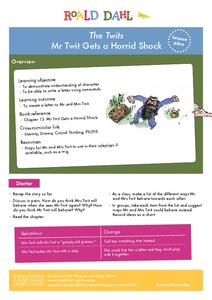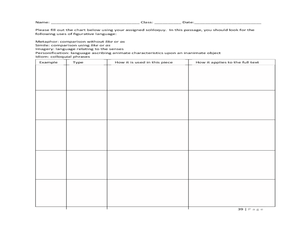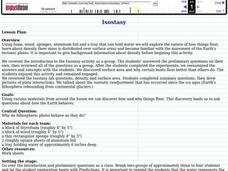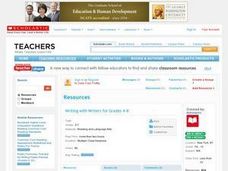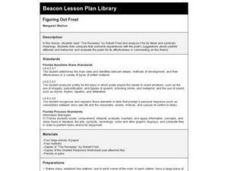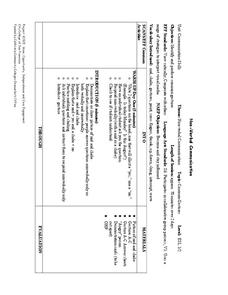Curated OER
Idiom Ideographs
Pupils explore idioms. They divide into groups of three. Each group is given an idiom and three sentence clues. They discuss the meaing of their assigned idiom. Students create a new sentence using their idiom and dramatize the idiom.
Curated OER
Idioms
Students study the meanings of idioms containing the phrase "up" or "down." In this language lesson, students are given an online scenario where the idiom phrases are used. Students answer multiple choice questions about their meaning.
Curated OER
Poetry: Metaphor
Ninth graders investigate the uses of metaphor in poetry. They construct poems demonstrating the correct usage of metaphors.
Roald Dahl
The Twits - Mr Twit Gets a Horrid Shock
Mr. and Mrs. Twit do not treat each other very nicely. The sixth lesson in an 11-part unit designed to accompany The Twits by Roald Dahl explores the way the characters talk to and treat one another. Role play and writing activities...
Curated OER
Soliloquy Performances
Students investigate soliloquies. In this performing arts lesson, students discuss figurative language within soliloquies and then perform a soliloquy to the rest of the class.
Curated OER
Common Idioms 1
In this language arts worksheet, pupils learn that idioms are spoken or written sentences where the meaning is not obvious. Students match the 10 idioms to their meanings.
Curated OER
Daily Oral Language Activities: Idioms
Third graders examine the use of idioms. For this vocabulary and reading lesson, 3rd graders explore what idioms are and make their own idiom cards to help them understand the use idioms in language.
Curated OER
Poetry in Motion
Sixth graders answer questions about "From a Railway Carriage." They discuss different poetical forms. They work together to write a poem about travel.
Curated OER
Flora and Fauna as Figures of Speech
Students view artwork in manuscript pages depicting insects, animals, plants, flowers, and ornate writing, such as those found in the Mira calligraphiae monumenta in the Getty Museum.
Curated OER
I Have a Metaphor
Learners locate the literary devices used in Martin Luther King Jr.'s "I Have a Dream" speech. In this figurative language lesson plan, students first distinguish between similes, metaphors, analogies, personification, etc. Learners...
Curated OER
Write with Writers
Write and work with authors on the Scholastic Website to promote the recognition of various genres. Young writers will participate in activities based on the type of writing such as biography, descriptive, folktales, mystery, news,...
PBS
Does Art Imitate Life?
Write what you know, sound advice for any writer and something many famous authors are known to have done. Use these materials to explore how Shakespeare's life influenced his plays. This resource is packed with readings, video segments,...
Curated OER
Combining Direct and Indirect Object Pronouns
Young scholars combine direct and indirect pronouns in this lesson. They practice with rewriting sentences when a direct and indirect object is present. They create a story using PowerPoint with their new sentences.
Curated OER
Awesome Animals
Sixth graders write descriptive narratives about animals. In this descriptive writing instructional activity, the teacher models how to write a paragraph with interesting sensory words and exciting verbs. Students choose a picture of an...
Curated OER
The Power of Poetry
Students utilize the Internet to research figures of speech used in poetry and poetry terms
Curated OER
Alliterations Allowed
Fourth graders recognize and create alliterative language in both literary and commercial use. In this language arts lesson, 4th graders analyze pieces of poetry and focus on the use of imagery, personification, and figures of speech.
Stanford University
Lesson Plan: Montgomery Bus Boycott
Most of us have heard of Rosa Parks, the Montgomery Bus Boycott, and Martin Luther King, Jr. But what about Claudette Colvin, Virginia Durr, Freedom Summer, or the Birmingham Children's Crusade? A five-lesson unit prompts class...
Curated OER
Figuring Out Frost
Fourth graders read "The Runaway" by Robert Frost and analyze it for its literal and symbolic meanings. They compare their personal experiences with the poet's suggestions about youthful attitudes and behaviors. Some nice worksheets are...
Curated OER
Charles Darwin Meets John Paul II
If you teach AP English language and composition and are looking for a way to address the differences between written and spoken arguments, consider this lesson. Over the course of three days, class members research Charles Darwin or...
Curated OER
Postcards in Time
Students write and send postcards to and from famous historical figures.
Curated OER
Personification Stories
Students create a clay object in which they are to personify. They use their own personal experiences to help the viewer imagine what it would be like to be that particular object. They also watch videos of fables to help them with...
Curated OER
Emotion Similes
Students define what a simile is before writing a poem that is based primarily on similes. They brainstorm and write the poem using the give format. They write drafts, revise and present a final poem.
Curated OER
Non-Verbal Communication
Young scholars investigate the concept of non-verbal communication and how it is conducted in various social contexts. They use pictures in order to see the kinds of emotion that can be expressed with the posture of the body or looks of...
Curated OER
Poetry and PowerPoint
Third graders read and discuss the poem, "April Rain Song" by Langston Hughes. After brainstorming examples of vivid verbs, figures of speech, language patterns, and imagery used in the poem, 3rd graders write a poem on a topic of...



